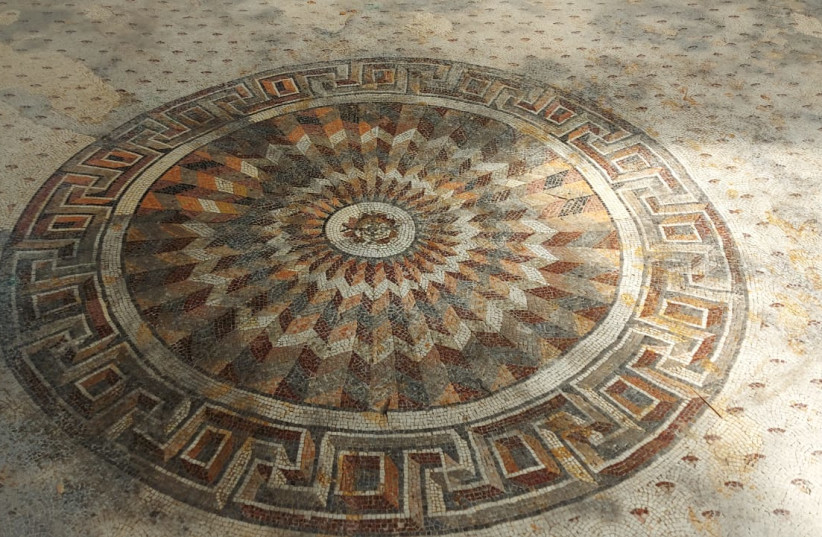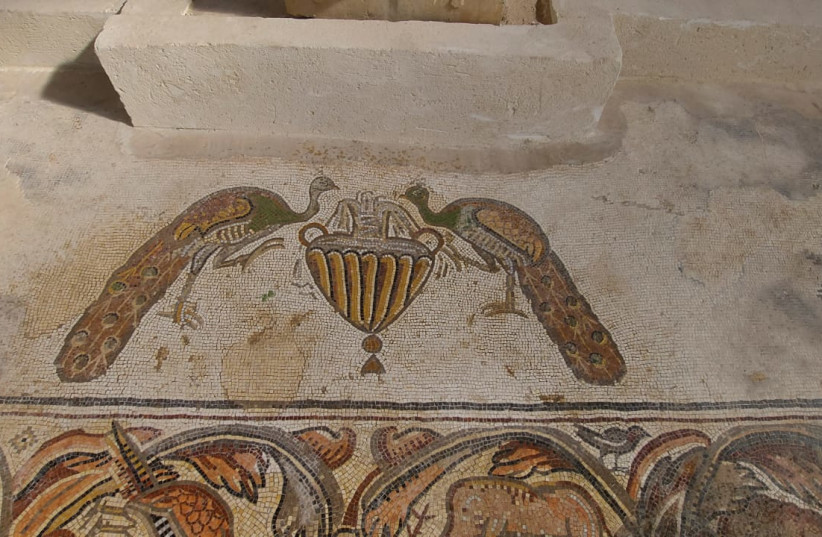Impressive Byzantine mosaic restored 30 years after its discovery, made available for the public
Mosaic part of church complex destroyed and burned in the Persian-Sassanid invasion of 614 CE

Restoration of a spectacular mosaic floor from a Byzantine-period Christian basilica was recently completed in a residential neighborhood of Nahariya. The site will now be open to the public some 30 years after it was first uncovered in a salvage excavation by the Antiquities Authority.
Resplendent with over 100 medallions, of which 87 survived, the large mosaic – more than 500 square meters (597 square yards) – is richly decorated with images of daily life, including animals, humans, shepherds, hunting scenes, grapes, pomegranates and symbols of Christianity in green, red, yellow, brown, white and black, IAA regional director Kamil Sari said.
In the center of the floor is a stunning rosette with an optical three-dimensional illusion, which has survived the centuries almost in its entirety.
The mosaic floor was part of a church complex built around 550 CE that was destroyed and burned in the Persian-Sassanid invasion of 614 CE, he said. Signs of the destruction can be seen on the mosaic floor, with black and white stains in some places. Large amounts of molten lead were also found at the site.
The church complex was built on the remains of an earlier temple from 4,500 year ago.

Restoration of a spectacular mosaic floor from a Byzantine-period Christian basilica was recently completed in a residential neighborhood of Nahariya some 30 years after it was uncovered by the Israel Antiquities Authority. The 500-square-meter mosaic decorated with images of daily life. (credit: ELI OKNIN)
“From the decorations of the basilica, we see that the person who built it was very wealthy and invested a lot of money to build it,” Sari said, adding that an inscription in old Greek indicates the church was built by the archbishop of Tyre, modern day Sidon, Lebanon.
The site was first discovered in 1964, when the municipality wanted to construct a community center. The mosaic was then covered up until 1974, when excavations were carried out by IAA archaeologists.
To preserve the site, the city of Bielefeld, Germany, a twin city of Nahariya, funded a large structure above the site. In 1988, a delegation of experts arrived from Bielefeld to restore fragments of the mosaic floor. The site was opened to the public in March 1980 for four years and was closed again due to the operating costs.
Two years ago, Nahariya Mayor Ronen Marley helped advance the restoration project together with the IAA, in collaboration with local students and volunteers working on the excavation. Marley, who was elected in 2018, replaced Jackie Sabag, who was the mayor for 30 years.
The Nahariya Byzantine basilica is the best preserved of the handful of Byzantine church remains that have been discovered in the area, said Eli Oknin, a member of the Nahariya Municipality tourism committee. Oknin and fellow tour guide Ronny Peled were volunteer co-founders of the restoration project.
“The site was closed to visitors for 30 years, and thanks to the cooperation among the mayor and the municipality, the Antiquities Authority and a group of local volunteers, it has now been opened,” Oknin said. “This should be a message for everybody that things can be accomplished with cooperation.”
The Nahariya Municipality hopes the new site will bring a much-needed push to local tourism. The site is now open to groups with prior registration on its website from Sunday through Thursday and to individual visitors on Fridays, also with prior registration. The site is closed on Shabbat out of respect for the neighborhood’s religious residents.
“The mayor quickly understood the importance of the site and that he had a treasure here, revealing the long history of the area of Nahariya,” Sari said. “He understood the potential this place has for tourism and teaching students about the history here and connecting them to the heritage of this area.”
Sari said the excavation of the church complex had special significance for him as a Christian from Haifa.
During the Byzantine period, most churches were located in the Lower Galilee, where Jesus was most active, and the discovery of the church complex in this area provides an important addition to the understanding of Christian history in the Western Galilee, he said.
“We know that during the Roman period, Jesus was very active in the Lower Galilee, in Nazareth and Kafr Kanna,” Sari said. “Then suddenly, when we have this archaeological site in the Western Galilee, we see that Christianity was flourishing quickly here. Maybe an apostle [of Jesus] or later Christians made the Western Galilee a focus to spread Christianity where there weren’t any Christians before.”
The rectangular basilica was 28 meters long (92 feet) and 17.70 meters (58 feet) wide and was built in the early sixth century CE, the peak of the Byzantine period.
The basilica is a Roman architectural structure that was used for communal meetings and was later adopted as a model for churches.
As is customary in basilicas, the church hall is divided by two rows of six marble columns. The columns were topped with capitals with floral decorations. According to the excavators, the columns supported wooden beams on which stood two galleries the width of the main nave of the church.
In front of the central apse, which was the largest of the three apses in the eastern part of the basilica, stood a platform with two or three steps leading up to it.
The platform was blocked off by 12 marble slabs, just over half a meter in height (1.6 feet) and almost 1.5 meters (five feet) wide. Ten marble pillars separated the marble slabs.
The marble slabs and columns were decorated with reliefs. Each of the tablets featured a Greek inscription dedicated to the priest Leonitis and his family members who were the donors of the tablets. Two of the tablets were decorated with two deer facing the center with a cross between them.
Two marble tables stood in the area blocked off by the marble slabs, and crosses were engraved on some of the table legs, which were designed like pillars. In addition, the three Greek letter equivalents of IAP were engraved at the top of the pillar-like table legs, which archeologists believe may have stood for Ioannes, who was archbishop of Tyre at the time.
The walls of the church were built of a local stone and were thickly plastered. According to the researchers, windows were installed in the church walls. Archaeological finds have included many fragments of flat glass, most likely from these windows. Seven large storage jars and clay plates were also found on the south side of the church near the apse.
“This is the realization of two years of intensive work,” IAA director Eli Eskozido said at the official inauguration of the site last week. “Professional restoration experts together with dedicated and committed volunteers from the community cleared the area of debris and garbage that had collected at the site over the past 30 years and worked to make it presentable to the public.
“The initiative was successful thanks to the cooperation with the city of Nahariya and the local community. It is a very exciting moment for us.”
THIS PAGE WAS POSTED BY SPUTNIK ONE OF THE SPUTNIKS ORBIT BLOG

No comments:
Post a Comment
Stick to the subject, NO religion, or Party politics